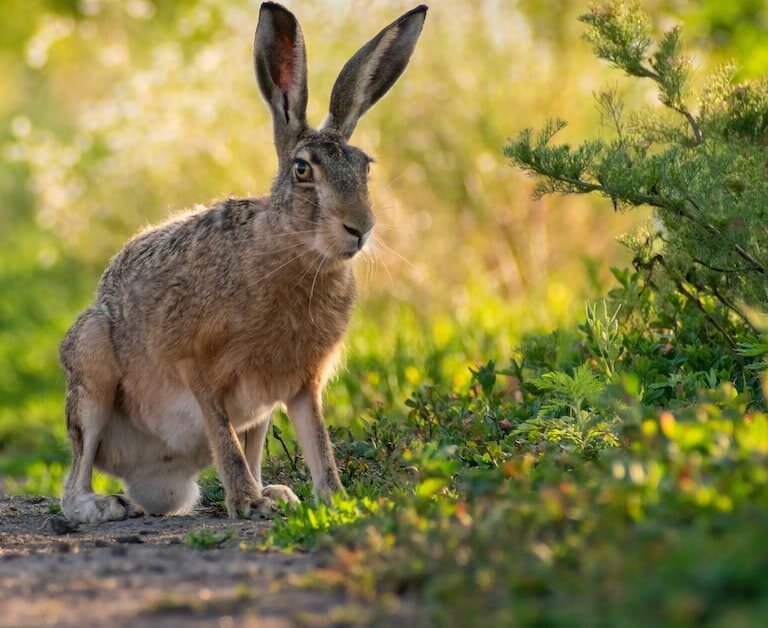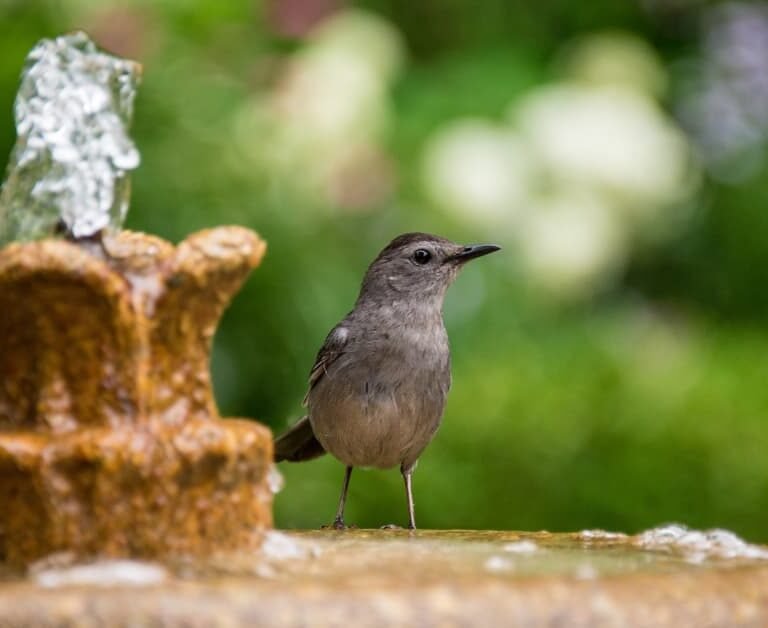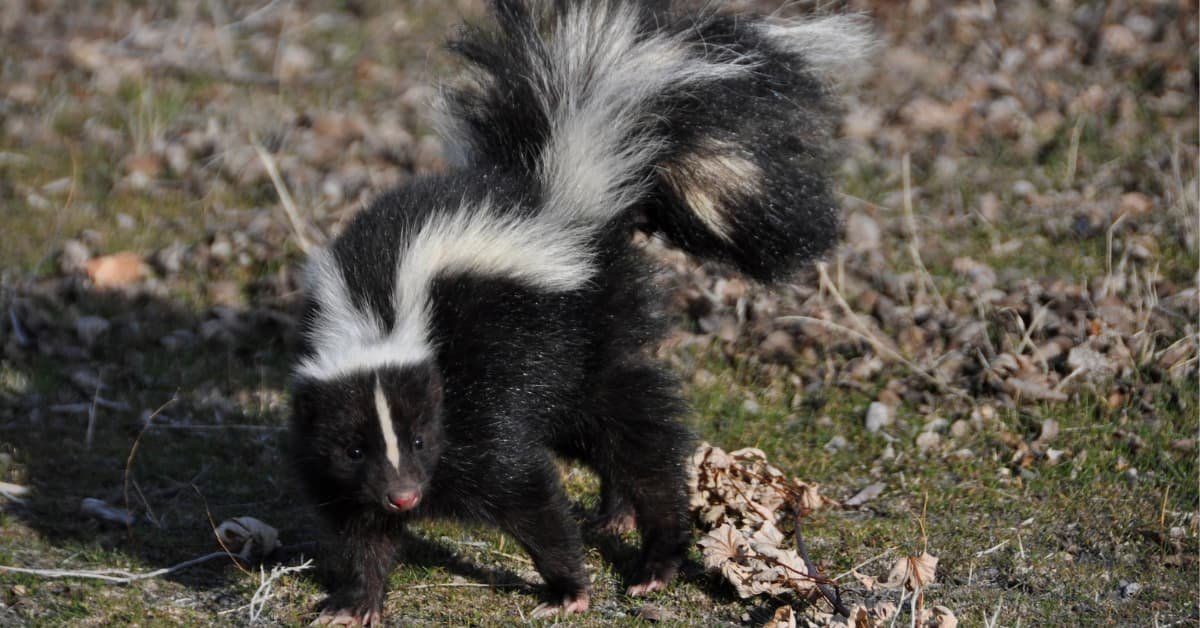
Have you ever wondered if skunks have the ability to climb trees or other structures? You might be surprised to learn that these nocturnal animals have some impressive climbing abilities.
We’ll explore everything you need to know about the fascinating world of skunk behavior and habitat. We’ll also be taking a look into their physical characteristics and the reasons behind their climbing habits.
Can Skunks Climb?
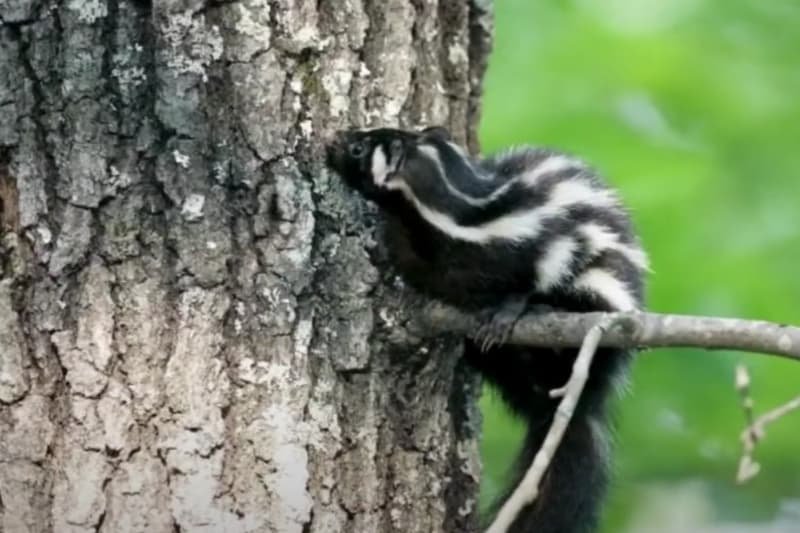
Yes, Skunks are great climbers! Skunks are best known for their distinct black-and-white coloring and potent odor, but skunks can climb!
Skunks’ Physical Abilities For Climbing
Skunks have several physical traits that contribute to their climbing abilities. While they are not considered experts in this area, skunks will climb a fence, trees, and other structures when necessary.
One notable feature that aids them in climbing is their long, curved claws on both their front and hind legs.
Another important characteristic that supports skunks’ climbing capabilities is their muscular limbs and flexible body structure. This allows them to tackle different angles and maintain balance as they ascend or descend various objects.
Moreover, some species of skunk – such as spotted skunks – have greater agility than others due to genetic traits which further enhance these physical attributes.
Evidence Of Skunks Climbing Trees And Structures
Skunks may not be the first animal you’d think of when it comes to climbing skills, but they are actually quite adept at scaling trees and structures. They have sharp claws that allow them to dig into bark or climb up wire mesh fences.
The spotted skunk, for instance, is a great fence climber and can scale structures to access food or shelter. Additionally, there have been reports of skunks climbing trees in search of nesting sites or prey.
Reasons Why Skunks Climb
Skunks climb for various reasons, including seeking shelter or food, escaping predators, and searching for mates.
Seeking Shelter Or Food
Skunks are known for their love of scavenging and have a reputation for getting into trash cans and other sources of food. They are often seen rooting around in gardens looking for insects, fruits, and vegetables to eat.
But skunks will also climb structures when they need shelter or a place to rest during the day. If you discover that a skunk has climbed up onto your roof or settled into a tree in your yard, it’s likely because they’re seeking safety from predators or wants to find a cozy spot away from the hustle and bustle of daily life.
Escaping Predators
Another reason why skunks will climb is to escape predators. Skunks have a distinctive defense mechanism – they can spray their attackers with a noxious liquid from their anal glands, which can cause temporary blindness and discomfort.
However, this defense mechanism only works at close range, meaning that skunks need another way of escaping predators in the wild.
In urban areas where natural habitats are scarce, skunks may seek shelter under decks or other man-made structures and become susceptible to pets like dogs and cats.
In order to outrun these animals or avoid conflict altogether, skunks will often opt for climbing fence posts or even scaling small trees if necessary.
Searching For Mates
Skunks are social animals that search for mates during the mating season, which occurs in late winter or early spring. During this time, male skunks will venture out in search of a female mate.
Once a suitable mate is found, the male skunk will engage in a courtship ritual that involves nuzzling and sniffing his potential partner. If the female is receptive to his advances, they will mate.
Skunks may also climb trees and structures in their search for mates as they travel through various habitats looking for potential partners.
Skunk Behavior And Habitat
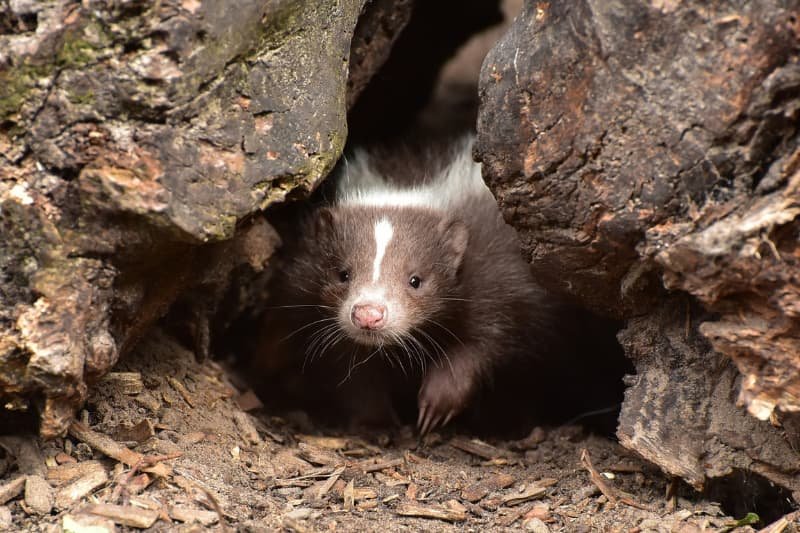
Skunks are nocturnal animals that prefer to live in forested areas, but they have adapted well to urban environments. They are opportunistic feeders and will forage through garbage cans and compost piles.
Types Of Skunks That Climb
Skunks are adaptable animals that can thrive in different environments, including forests, deserts, and even urban areas. When it comes to climbing, some skunk species are better climbers than others. Here are the types of skunks that can climb:
- Eastern Spotted Skunks – These skunks are known to be excellent climbers and can scale walls and fences easily.
- Striped Skunks – Although they are not as good at climbing as spotted skunks, striped skunks can still climb trees and structures with ease.
- Hooded Skunks – They are not known for their climbing abilities but have been observed climbing low tree branches or bushes in search of food.
- Hog-Nosed Skunks – These skunks prefer to stay on the ground but have been seen climbing small trees or shrubs when trying to escape from predators.
Overall, although some skunk species are better climbers than others, all subspecies of skunks have the ability to climb when necessary for survival.
How Skunks Climb
Skunks have impressive physical abilities that allow them to climb trees and other structures. They use their long claws and sharp teeth for digging into the bark of a tree or fence post, allowing them to cling tightly while they scramble up.
Skunks are not the most agile climbers in the animal kingdom, but they can handle fences that are up to 6 feet high. Some species of skunks, such as spotted skunks, are excellent climbers and can easily scale even higher barriers.
When threatened by predators or seeking food or shelter, skunks will not hesitate to climb whatever is necessary to reach their goals.
Natural Habitats
Skunks can be found in a variety of natural habitats, including woodlands, prairies, and suburban areas. They prefer to live in areas with ample sources of food and water, as well as plenty of hiding places for protection against predators.
Skunks are also known to burrow underground to create dens where they sleep during the day.
Despite their ability to climb trees and fences, skunks usually prefer to stay near the ground in search of food. They often forage for insects like beetles and grubs by digging into the soil with their long claws and sharp teeth.
While skunks may not spend much time high up in trees or on rooftops, it’s important to remember that they are still capable climbers when seeking out shelter or escaping danger.
Tips For Preventing Skunks From Climbing
Skunks may sometimes climb objects like trees, fences, and structures. Preventing skunks from climbing can help prevent unwanted interactions with these critters. Here are some tips to consider:
- Install barriers: Use mesh or wire fences that are at least 3 feet high, and extend below ground by about a foot. Block off any entry points into buildings.
- Trim trees: Keep tree branches trimmed back so they’re not in contact with roofs or other structures.
- Avoid leaving food out: Skunks are attracted to food sources such as pet food left outside, garbage cans, and compost piles.
- Seal off burrows: Cover any holes under sheds or decks with heavy-gauge wire mesh.
- Use repellents: Some repellents contain scent or taste deterrents that discourage skunks from entering the area.
By following these tips to prevent skunks from climbing around your property, you can take measures to minimize the risks of encounters with them while helping keep your property safe and secure.
What To Do When You Encounter A Climbing Skunk
If you encounter a climbing skunk, it is important to be aware and take safety precautions such as staying calm and keeping your distance. You should try to avoid startling the skunk and not approach it or attempt to touch it.
If possible, slowly move away from the area, giving the skunk plenty of space to climb down on its own.
Safety Precautions
It’s important to take safety precautions when encountering a climbing skunk. Here are some tips:
- Keep your distance and avoid startling the skunk.
- Do not approach or attempt to touch the skunk.
- If possible, try to slowly and calmly move away from the area where the skunk is climbing.
- Wear protective clothing such as gloves, long sleeves, and pants to prevent bites or scratches.
- Avoid cornering the skunk, as this may cause them to feel threatened and spray their musk as a defense mechanism.
- If you encounter a skunk in your home or property, do not attempt to trap or remove them yourself. Contact a professional wildlife removal specialist who can safely and humanely relocate the animal.
Remember that skunks are wild animals and should be treated with caution and respect. By taking proper safety precautions, you can protect yourself and avoid any potential conflicts with these fascinating creatures.
Humane And Safe Removal Methods
If you encounter a climbing skunk and need to remove it from your property, there are humane and safe ways to do so. Here are some methods to consider:
- Use a live trap: Set up a live trap in an area where the skunk is likely to pass through. Bait the trap with food that is appealing to skunks, such as canned cat food or fish. Once caught, cover the trap with a blanket and relocate the skunk at least 10 miles away from your property.
- Hire a wildlife removal specialist: If you’re not comfortable handling the situation yourself, hire a professional who has experience removing skunks safely and humanely. They can assess the situation and use appropriate methods for removal.
- Wait for it to come down: Skunks climb trees or fences but will eventually come back down on their own to search for food or shelter. Wait until it comes back down before taking any action.
- Use deterrents: There are various natural deterrents that may help keep skunks away from your property such as cayenne pepper or garlic spray around the perimeter of your property, removing any potential food sources like pet food left outside overnight, and keeping garbage cans sealed tightly.
Remember not to approach or try to handle a skunk on your own as they can spray unpleasant odors if they feel threatened. Instead, follow these safe removal methods to keep both you and the skunk out of harm’s way while maintaining harmony with wildlife in your area.
Contacting A Wildlife Removal Specialist
If you happen to come across a climbing skunk and do not know how to handle the situation, it is best to contact a wildlife removal specialist immediately. These experts have experience in safely removing animals and can provide humane solutions for everyone involved.
It is crucial to remember that attempting to remove a skunk on your own can potentially result in getting sprayed or even attacked. Wildlife removal specialists use proven methods such as live traps or exclusion techniques that prevent future entry into your property.
By contacting professionals, you also ensure compliance with applicable laws surrounding animal control.
Conclusion
Skunks are indeed capable climbers. Their physical abilities and evidence of climbing behavior suggest that they can climb trees, structures, and even fences up to six feet high.
Skunks may climb for a variety of reasons such as seeking shelter or food, escaping predators, or searching for mates. However, it’s important to take precautions when encountering a climbing skunk and opt for humane removal methods if necessary.
FAQs:
Can skunks climb trees or other high surfaces?
Yes, skunks are able to climb trees and other elevated structures such as fences or decks in order to search for food or escape potential predators.
Are there any particular species of skunks that are better climbers than others?
All species of skunks have the ability to climb with varying degrees of success depending on their size, shape, and agility. However, some sources suggest that spotted skunks may be more agile and nimble climbers than striped skunks due to their smaller size and unique physical adaptations.
Can a skunk enter my home by climbing?
In some cases, yes – if there is an opening or access point near the roofline of your home such as a vent or chimney without proper screening in place, a determined skunk could potentially make its way into your home.
What should I do if I encounter a climbing skunk on my property?
If you see a skunk climbing up onto your deck or into your tree line while outside on your property, it is best to keep a safe distance and let the animal pass by naturally without trying to interact with it directly.
If you suspect that the animal has taken up residence somewhere on your property like under a shed or porch space- consult with local wildlife removal professionals who can safely relocate the animal away from your living quarters without causing harm to either party involved.


